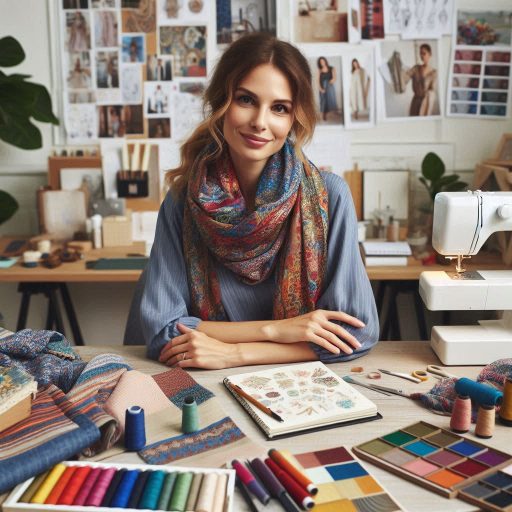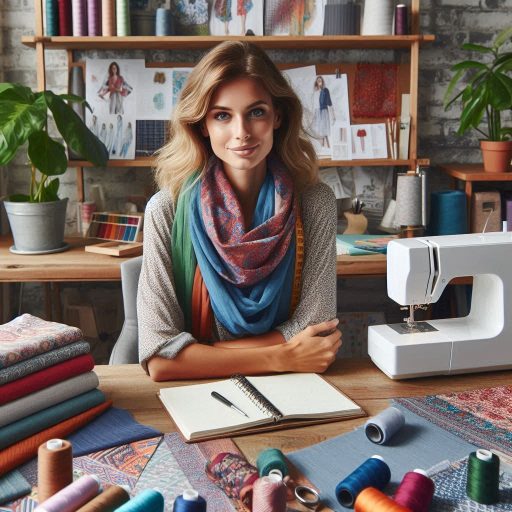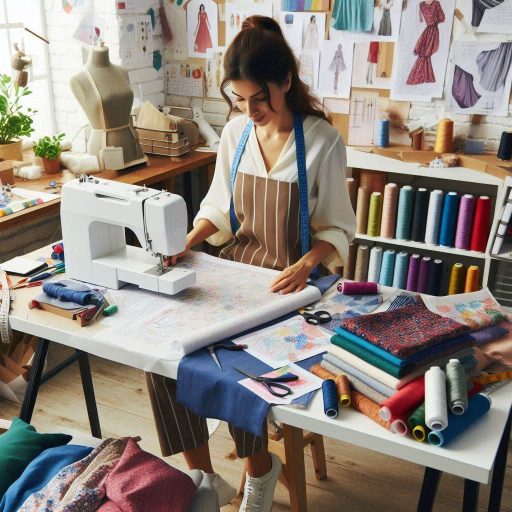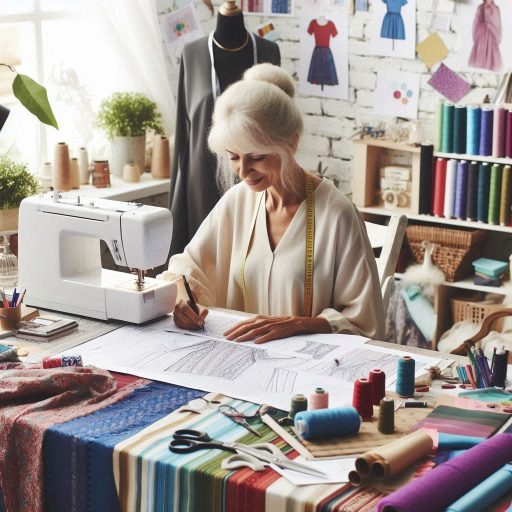Introduction
Textile design has evolved significantly over the centuries, reflecting cultural shifts and technological advancements.
Initially, artisans crafted textiles using simple hand techniques, relying on natural fibers and dyes.
This process was labor-intensive and time-consuming, resulting in unique but limited designs.
As industrialization took hold in the 18th and 19th centuries, mechanization transformed textile production.
Innovations like the power loom allowed for mass production, drastically changing the landscape of textile design.
Today, modern textile design encompasses a wide array of processes, including weaving, printing, and dyeing.
Designers now leverage advanced digital tools to enhance their creativity and precision.
Modern textile design integrates technology at every stage, from conceptualization to final production.
This integration allows designers to experiment with patterns, colors, and textures in ways that were previously unimaginable.
Technology plays a crucial role in shaping modern textile design.
With the rise of computer-aided design (CAD) and digital printing, designers can create intricate patterns and designs with ease.
These technologies facilitate faster production cycles and reduce waste, contributing to more sustainable practices within the industry.
Furthermore, advancements like 3D printing enable designers to explore new materials and create customizable textiles tailored to individual preferences.
The impact of technology on modern textile design extends beyond aesthetics.
Influence of Digital Printing on Textile Design
Digital printing has transformed modern textile design in remarkable ways.
This innovative technology allows designers to create intricate patterns and vibrant colors.
Here’s how digital printing revolutionizes the textile industry.
How digital printing has revolutionized the way patterns and designs are created
Digital printing enables designers to develop unique designs quickly.
Unlike traditional methods, it allows for complex imagery without sacrificing quality.
Designers can manipulate designs digitally, providing unprecedented flexibility.
This technology eliminates the need for screens or plates, reducing setup time significantly.
As a result, artists can experiment with various styles and aesthetics more freely.
Advantages of digital printing in terms of customization and speed
Customization
Digital printing excels in customization.
Designers can produce one-off pieces tailored to specific client needs.
This personalization fosters greater client satisfaction and loyalty.
Customers appreciate having unique designs that stand out from mass-produced textiles.
Speed
Speed is another significant advantage.
Digital printers operate much faster than traditional methods.
Designers can complete projects in days rather than weeks.
This rapid turnaround allows businesses to respond to trends swiftly, ensuring they remain competitive.
Cost-Effectiveness
Digital printing minimizes material waste.
Traditional printing often requires excess fabric to account for setup errors.
In contrast, digital printing only uses what is necessary.
This efficiency lowers production costs, making it accessible for smaller brands and independent designers.
Examples of successful textile designs created through digital printing
Numerous brands showcase the power of digital printing in their textile designs.
Here are a few noteworthy examples:
- Alexander McQueen: This luxury brand employs digital printing to create stunningly intricate patterns that captivate audiences.
- H&M: The fashion giant utilizes digital printing for quick turnaround times on its collections, allowing for frequent new releases.
- Spoonflower: This platform enables users to design their own fabric, showcasing the versatility of digital printing for individual creators.
- Nike: The sportswear company uses digital printing to customize apparel, allowing customers to personalize their gear uniquely.
- Eres: Known for luxury swimwear, Eres employs digital printing to produce eye-catching prints that differentiate its products.
Digital printing has undoubtedly revolutionized textile design.
Its influence extends from enhanced creativity to practical advantages like speed and customization.
Designers can push boundaries, experiment freely, and produce unique textiles that resonate with consumers.
The future of textile design will continue to thrive through digital innovation, ensuring exciting developments for years to come.
Read: Top Skills Needed for Art Educators and Instructors
Role of computer-aided design (CAD) software in textile design
Computer-aided design (CAD) software revolutionizes modern textile design.
It empowers designers to create intricate patterns and designs quickly and accurately.
Here’s how CAD software impacts textile design today.
How CAD software helps designers to create intricate patterns and designs
CAD software enables designers to:
- Visualize Ideas: Designers can turn concepts into detailed visuals instantly.
- Experiment with Colors: Users can easily test various color combinations on their designs.
- Create Complex Textures: CAD allows for the simulation of different fabric textures, enhancing design possibilities.
By using CAD, designers unlock endless creative avenues.
They can generate unique patterns that might be challenging with traditional methods.
The software’s intuitive interface makes it user-friendly, even for beginners.
Benefits of using CAD software in terms of efficiency and accuracy
Using CAD software in textile design brings several advantages:
- Increased Efficiency: Designers save time by quickly drafting and modifying designs.
- Enhanced Accuracy: CAD software reduces errors in measurements and scaling, ensuring precision in final products.
- Streamlined Production: The software can directly communicate with production machines, reducing the time from design to manufacturing.
- Easy Revisions: Designers can easily revise designs without starting from scratch, improving workflow.
These benefits lead to higher productivity and better quality outcomes for designers.
Case studies of designers who have incorporated CAD software into their workflow
Several designers have successfully incorporated CAD software into their workflows.
Here are a few notable examples:
- Sophie Hines: This designer uses CAD to create intricate floral patterns for her fabric lines.
By utilizing CAD, she reduced her design time by 50%, allowing for more collections each year. - Mark Thompson: A textile designer specializing in sustainable fabrics, Mark employs CAD for fabric simulations.
This technique helps him visualize how materials will look and behave before production, saving time and resources. - Laura Kim: Laura integrated CAD into her studio to enhance collaboration among team members.
With CAD, all team members can access and modify designs in real time, fostering creativity and efficiency.
CAD software plays a crucial role in modern textile design.
It helps designers create intricate patterns, enhances efficiency, and improves accuracy.
The success stories of designers like Sophie, Mark, and Laura highlight the transformative power of this technology.
As the textile industry continues to evolve, CAD will remain at the forefront, shaping innovative design practices.
Embracing this technology will pave the way for future advancements in textile design.
Read: Collaborating with Other Creative Roles
Impact of 3D Printing on Textile Design
3D printing revolutionizes textile design by enabling innovative textures and shapes.
This technology allows designers to create complex structures previously unattainable.
With 3D printing, designers can manipulate materials to produce unique patterns and styles.
How 3D printing has opened up new possibilities for creating innovative textures and shapes
3D printing opens new avenues for creativity in textiles.
Designers can now:
- Create intricate, customizable patterns
- Experiment with unusual materials
- Develop textures that enhance functionality
- Produce lightweight garments with structural support
This flexibility fosters innovation and encourages designers to push boundaries.
Transform Your Career Today
Unlock a personalized career strategy that drives real results. Get tailored advice and a roadmap designed just for you.
Start NowExamples of 3D Printed Textiles and Garments
Several brands successfully incorporate 3D printing into their collections.
Here are a few notable examples:
- Iris van Herpen: This designer is renowned for her 3D-printed garments that blend art and fashion seamlessly.
- Adidas: The company utilizes 3D printing technology to create customized footwear, allowing for personalized fit and comfort.
- Danit Peleg: Peleg’s collection showcases entirely 3D-printed clothing, proving the viability of this technology in everyday fashion.
These examples highlight the potential of 3D printing to transform conventional design practices.
Challenges and limitations of using 3D printing in textile design
Despite its advantages, 3D printing in textile design presents challenges.
Key limitations include:
- Material Constraints: Not all materials are suitable for 3D printing.
Designers often face limitations regarding texture and durability. - Production Speed: 3D printing can be slower than traditional manufacturing methods.
This may hinder large-scale production. - Cost Factors: High-quality 3D printers and materials can be expensive, making it difficult for smaller designers to adopt this technology.
- Technical Expertise: Designers must possess technical knowledge to effectively use 3D printing.
This requirement can create a barrier for some creatives.
3D printing significantly impacts modern textile design by enhancing creativity and innovation.
This technology offers unique possibilities for textures and shapes, enabling designers to push traditional boundaries.
However, challenges such as material limitations, production speed, and cost remain.
As technology advances, we can expect even more exciting developments in 3D printed textiles.
Embracing this technology could lead to a more sustainable and innovative future in fashion.
Read: Breaking Down Iconic Movie Costumes

Sustainability in Modern Textile Design
Technology has revolutionized modern textile design, enabling designers to create sustainable textiles through eco-friendly processes.
This shift toward sustainability is crucial in the fashion industry, where environmental impact remains a pressing concern.
How technology has enabled designers to create sustainable textiles through eco-friendly processes
- Digital Printing: Digital printing minimizes waste by using precise amounts of ink.
This method reduces water consumption compared to traditional dyeing techniques. - Recycled Materials: Designers increasingly use recycled fibers, such as recycled polyester from plastic bottles.
This practice lessens reliance on virgin materials and reduces landfill waste. - 3D Knitting: 3D knitting technology allows for the creation of garments with minimal material waste.
Designers can produce garments on-demand, preventing overproduction. - Biodegradable Fabrics: Innovations in fiber technology have led to the development of biodegradable fabrics.
These materials break down naturally, reducing long-term environmental impact. - Supply Chain Transparency: Technology enables better tracking of materials and processes.
This transparency helps consumers make informed choices about sustainable products.
Importance of sustainable practices in the fashion industry
Sustainable practices in textile design are vital for several reasons:
- Environmental Protection: Reducing harmful waste and emissions protects ecosystems and biodiversity.
- Consumer Demand: Today’s consumers prefer brands committed to sustainability.
They seek products that reflect their values and beliefs. - Regulatory Compliance: As regulations around environmental impact increase, brands adopting sustainable practices will better comply and thrive.
- Long-Term Viability: Sustainable practices promote long-term viability for brands, ensuring their relevance in an evolving market.
Case studies of brands that are leading the way in sustainable textile design
Several brands are pioneering sustainable textile design through innovative practices:
- Patagonia: Patagonia uses recycled materials and promotes fair labor practices.
Their commitment to sustainability sets industry standards. - Eileen Fisher: Eileen Fisher focuses on organic materials and responsible production methods.
Their initiatives emphasize a circular economy. - Reformation: Reformation integrates technology to measure their environmental impact.
They use sustainable fabrics and promote transparency in their supply chain. - Adidas: Adidas has embraced sustainable innovation, using recycled ocean plastics in their footwear.
Their Parley line exemplifies this commitment. - Nudie Jeans: Nudie Jeans promotes organic cotton and provides free repairs.
They emphasize longevity and sustainability in their products.
Technology has profoundly impacted modern textile design, fostering sustainability through innovative processes.
The importance of sustainable practices in the fashion industry cannot be overstated.
By examining leading brands, we see how commitment to eco-friendly textiles shapes a more sustainable future.
As technology continues to evolve, so will the possibilities for sustainable design, ultimately benefiting our planet and its inhabitants.
Read: Networking Events for Costume Designers
Virtual reality (VR) and augmented reality (AR) in textile design
How VR and AR technology are being used to visualize and simulate textile designs
Virtual reality (VR) and augmented reality (AR) are transforming textile design.
These technologies enable designers to visualize and simulate their creations.
Designers can explore three-dimensional spaces and manipulate designs in real time.
This immersive experience enhances creativity and innovation in the textile industry.
VR allows designers to step inside their designs.
They can interact with textures, colors, and patterns in a virtual environment.
This process streamlines decision-making and eliminates guesswork.
Designers gain a clearer understanding of how fabrics will look and feel.
They can make adjustments instantly, ensuring their vision is realized.
AR technology overlays digital elements onto the real world.
Designers can use AR to view fabric patterns on actual garments.
This interactive approach enables better visualization of how a design fits into a specific context.
By seeing designs in their intended environment, designers can make informed adjustments.
Benefits of using VR and AR in terms of cost savings and time efficiency
The cost savings associated with VR and AR are significant.
Traditionally, creating prototypes requires substantial resources and time.
With VR and AR, designers can reduce the number of physical samples needed.
This shift decreases material waste and production costs.
Businesses benefit from faster turnaround times and increased efficiency.
Moreover, time efficiency becomes a crucial factor.
Designers can quickly iterate on their concepts using VR and AR tools.
They no longer need to wait for physical samples to arrive.
This accelerated process helps bring products to market faster.
As a result, companies can respond to trends and consumer demands more swiftly.
Examples of companies utilizing VR and AR in textile design
Several companies are successfully utilizing VR and AR in textile design.
For instance, IKEA employs AR to help customers visualize how textiles look in their homes.
Customers can see how fabrics blend with their decor choices.
This approach enhances customer engagement and satisfaction.
Another example is Adidas, which integrates VR in its design process.
The company uses VR to develop and test new sneaker designs before production.
This method streamlines collaboration among designers, engineers, and marketing teams.
They can share feedback and make improvements rapidly.
In the fashion sector, brands like Hugo Boss leverage VR for runway shows.
They create virtual experiences that allow consumers to see collections in an immersive way.
This strategy enhances brand visibility and connects with audiences on a deeper level.
In summary, VR and AR are revolutionizing textile design.
These technologies enable designers to visualize and simulate their ideas effectively.
They offer substantial cost savings and time efficiency.
With examples from leading companies, it is clear that VR and AR shape the future of textile design.
As the industry continues to evolve, embracing these technologies will be essential for success.
Future trends in technology and textile design
The textile design industry is rapidly evolving due to technological advancements.
These changes promise to reshape how designers create and produce fabrics.
Here are some key predictions and insights into future trends.
Predictions on how technology will continue to shape the future of textile design
- Increased Automation: Automation will streamline production processes, enhancing efficiency and reducing labor costs.
Smart machines will take over repetitive tasks. - Enhanced Customization: Technology will enable mass customization of textiles.
Consumers will choose patterns, colors, and materials tailored to their preferences. - Sustainability Innovations: The focus on sustainable practices will grow.
Technologies like 3D printing will reduce waste and minimize resource consumption. - Smart Textiles: The rise of smart textiles will integrate electronic components into fabrics.
These textiles will respond to environmental changes, enhancing functionality.
Emerging technologies that may have a significant impact on the industry
Several emerging technologies will significantly influence the textile industry:
- 3D Printing: This technology allows for rapid prototyping and unique designs.
Designers can create intricate patterns without the constraints of traditional manufacturing. - Artificial Intelligence (AI): AI will analyze market trends and consumer preferences.
It will help designers create collections that resonate with target audiences. - Virtual Reality (VR) and Augmented Reality (AR): These technologies will revolutionize the design process.
Designers can visualize concepts in immersive environments before production. - Blockchain Technology: Blockchain will improve transparency in the supply chain.
It will ensure traceability of materials, promoting ethical practices.
Opportunities and challenges that come with the integration of technology in textile design
The integration of technology in textile design presents numerous opportunities:
- Enhanced Creativity: Technology enables designers to experiment with new materials and techniques.
This fosters innovation and pushes creative boundaries. - Global Collaboration: Technology facilitates collaboration among designers worldwide.
Online platforms enable sharing ideas and resources seamlessly. - Faster Time to Market: Automated processes will reduce production time.
Designers can bring collections to market faster, responding quickly to trends.
Challenges of Technology Integration
Despite the opportunities, challenges exist with technology integration:
- High Initial Costs: Investing in advanced technology can be expensive.
Small businesses may struggle to afford these upgrades. - Skills Gap: The industry needs skilled professionals who understand new technologies.
Training and education programs must evolve to meet this demand. - Dependence on Technology: Over-reliance on technology may hinder creativity.
Designers must balance traditional skills with new innovations.
Technology will continue to shape the future of textile design.
As designers embrace automation, smart textiles, and sustainable practices, the industry will transform.
By addressing challenges and seizing opportunities, textile design can thrive in a tech-driven world.
Conclusion
Technology profoundly impacts modern textile design, reshaping how designers create and innovate.
It enhances creativity, efficiency, and sustainability in ways previously unimaginable.
With the advent of digital tools, designers can now experiment with unique patterns and intricate textures.
Techniques like 3D printing allow for rapid prototyping, enabling designers to bring their visions to life more quickly and accurately.
Moreover, the integration of smart textiles opens new avenues for functionality and wearability.
These innovative fabrics can respond to environmental changes, offering dynamic experiences for consumers.
Automation also streamlines production processes, reducing costs and minimizing waste, which is essential in today’s environmentally conscious market.
As we’ve discussed, technology is not just a tool; it’s a transformative force that can redefine the industry.
Designers must embrace these advancements to stay relevant and competitive.
By adapting to new technologies, you can drive innovation and set trends rather than follow them.
I encourage you to explore the latest tools and techniques in your design process.
Attend workshops, collaborate with tech experts, and stay updated on emerging technologies.
The future of textile design depends on your willingness to evolve.
Stay curious, experiment boldly, and lead the charge in this exciting and rapidly changing field.
Your adaptability will not only enhance your designs but also inspire others to innovate.




